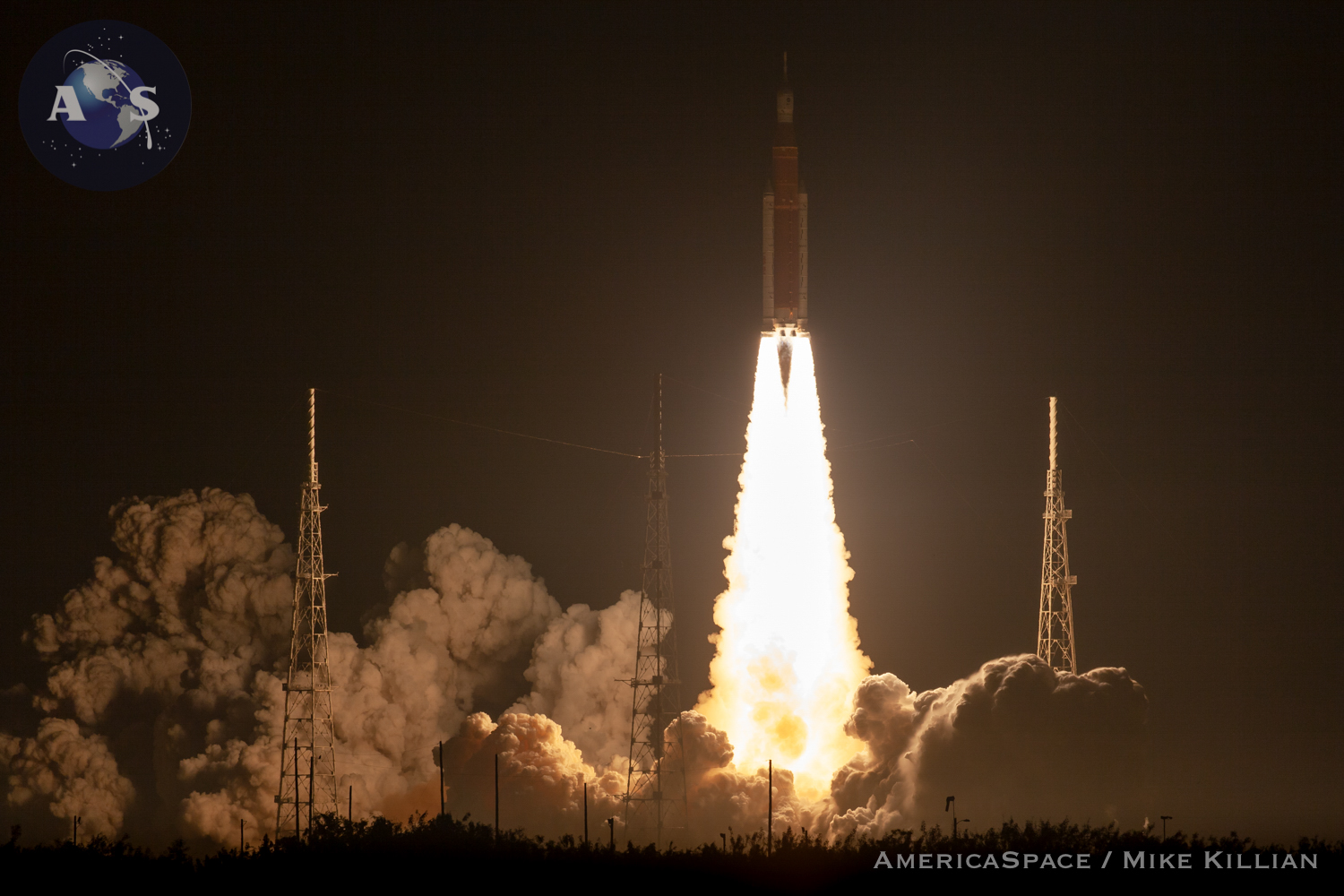
A year ago today, following more than a decade in development, NASA’s mammoth Space Launch System (SLS) rocket finally took flight from historic Pad 39B at the Kennedy Space Center (KSC). Raising the hopes of a generation—“For the Artemis Generation,” Artemis I Launch Director Charlie Blackwell-Thompton intoned in the final minutes before liftoff, “this is for you”—the 322-foot-tall (98-meter) behemoth took flight at 1:47:44 a.m. EST, kicking off a 25-day mission which saw an uncrewed Orion Crew Module (CM) and European Service Module (ESM) voyage to the Moon and back to Earth.
The launch of Artemis I was the first U.S. crew-capable rocket to fly its maiden outing in the hours of darkness, a realistic possibility first outlined in September 2022 by NASA Associate Administrator for the Exploration Systems Development Mission Directorate Jim Free. In his remarks, Mr. Free noted that the space agency’s preference was to fly in conditions of daylight, since “visuals from our long-range tracking are of benefit to us”, there nevertheless remained “some ways to view the vehicle” if it did fly at night.
And less than two hours into 16 November 2022, Artemis I did just that.
In some ways, Artemis I’s spectacular liftoff drew uncanny parallels with Apollo 17, the most recent flight of humans to lunar distance. Launched at 12:33 a.m. EST on 6 December 1972 atop a mighty Saturn V, that mission to the Moon’s Taurus-Littrow highland region saw Commander Gene Cernan and his Apollo 17 crewmates, Command Module Pilot (CMP) Ron Evans and Lunar Module Pilot (LMP) Harrison “Jack” Schmitt, turn Florida’s night into day with their own man-made sunrise.
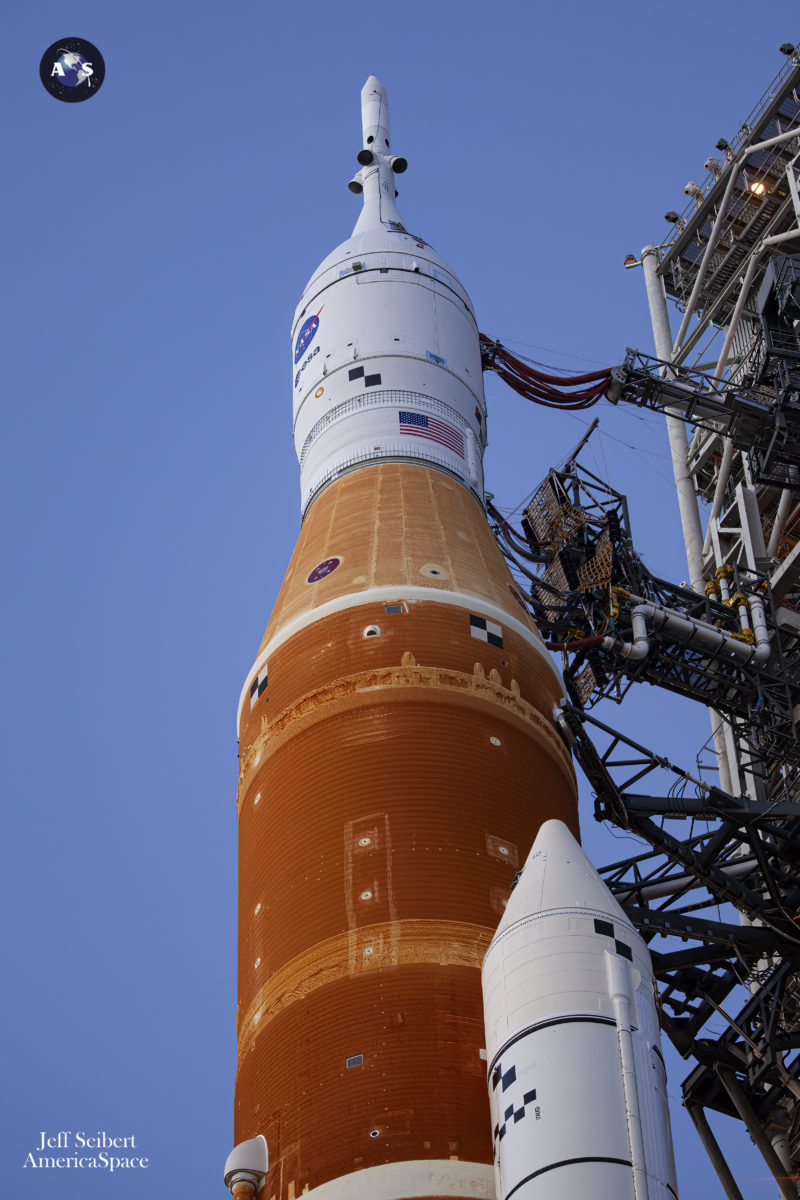
Theirs was the first U.S. manned night launch and until Artemis I also the only Moon-bound flight of a crew-capable vehicle to fly under cover of darkness. Aboard Apollo 17, Cernan later remembered the fiery glare of the Saturn reflecting off the clouds and the interior of the shuddering cabin seemed “painted” with an ethereal reddish hue.
“It’s lighting up the sky,” breathed an astonished NASA public affairs commentator Jack King as Apollo 17 speared skyward, more than a half-century ago. “It’s just like daylight here at the Kennedy Space Center.”
But 16 November 2022’s successful launch of Artemis I came after multiple months of agonizing frustration. The giant rocket—whose “business end” comprised the 212-foot-tall (64.6-meter) Boeing-built Core Stage with four shuttle-era RS-25 engines and a pair of five-segment Solid Rocket Boosters (SRBs), fabricated by Northrop Grumman Corp.—rolled out from KSC’s iconic Vehicle Assembly Building (VAB) to Pad 39B in mid-August, tracking an opening salvo of launch attempts in late August and early September.
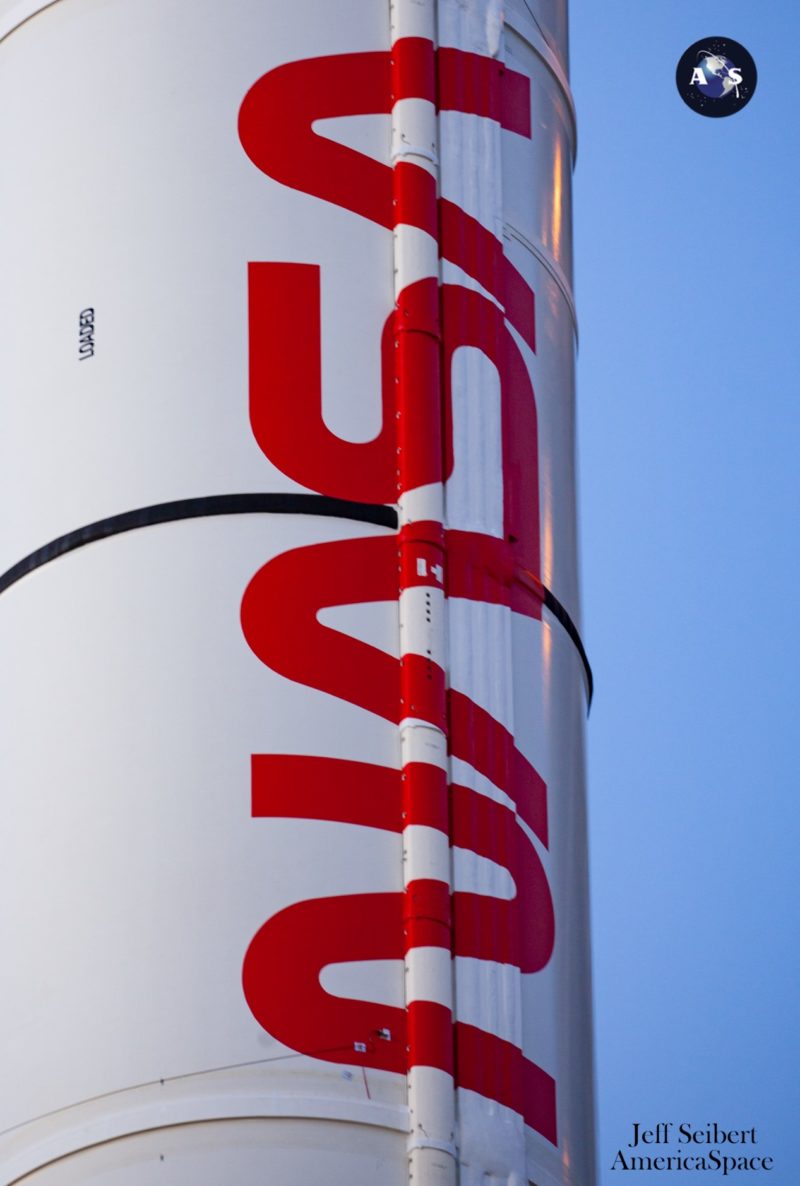
But the first launch try on the 29th came disappointingly to nought when efforts to thermally condition the RS-25 engines ahead of ignition met with stubborn resistance from Engine No. 3, which refused to reach its requisite temperature range. An added woe was a “spike” in the amount of hydrogen leakage into the “purge can”, a housing which covered the Tail Service Mast (TSM) umbilical’s 8-inch (20-centimeter) quick-disconnect fitting. Engineers managed the leak by manually adjusting propellant flow rates.
NASA next aimed to fly on 3 September 2022, with plans to chill-down the engines 30-45 minutes sooner in the countdown to solve the recalcitrant thermal conditioning issue and avoid the necessity of rolling the stack back to the VAB. A flex-hose and loose pressure sensor line were replaced and bolts were tightened as part of efforts to rectify the TSM umbilical leak.
But the second attempt also proved fruitless, as the hydrogen leak—situated right on the interface between the ground-side and flight-side plates of the quick disconnect fitting—recurred and proved maddeningly intractable. Three tries by engineers to re-seat the seal came to nothing and the 3 September attempt, too, was scrubbed.
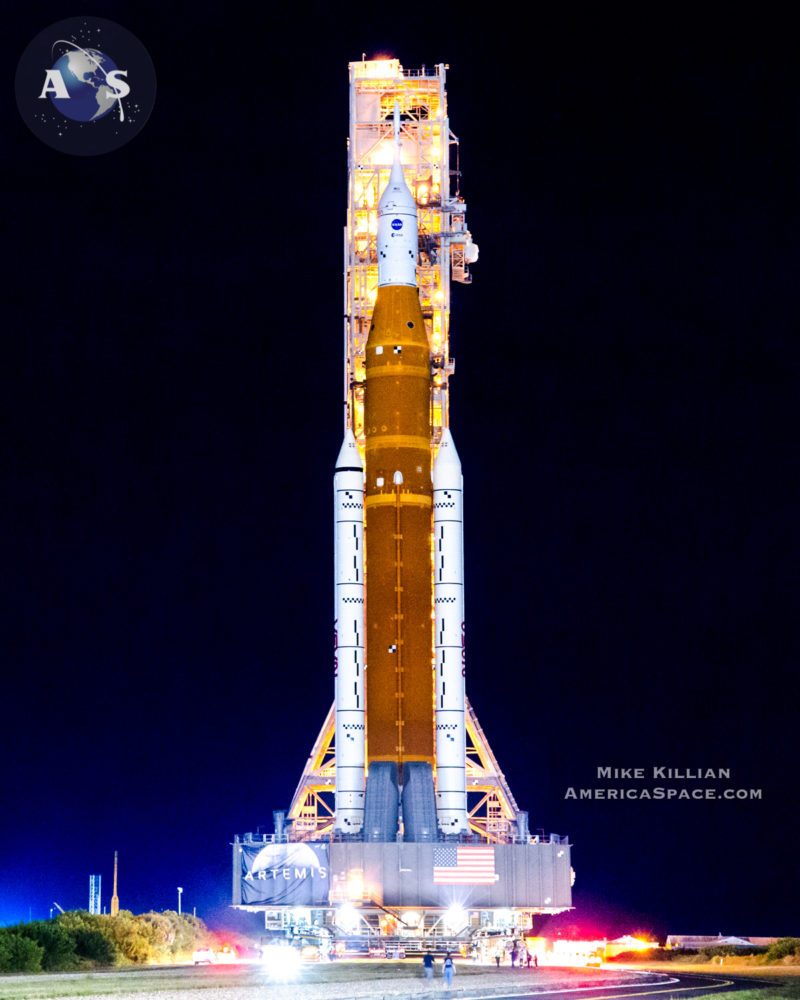
Hopes of a third try in early September were abandoned, as teams established a tent-like weather/environmental protection shelter around the base of the SLS and the 8-inch quick disconnect for exploratory and repair work. They replaced a pair of seals: one around the 8-inch interface and another around the 4-inch (10-centimeter) bleed line which would be used to redirect some propellant during the tanking process.
A cryogenic test of the repair, originally targeted for 17 September, eventually took place on the 21st, following what NASA described as “careful consideration of multiple logistical steps”. All four objectives of the test—assessing the effectiveness of the hydrogen leak repair, loading propellants successfully into the SLS tanks under new procedures, conducting a “kick-start bleed” to thermally condition the RS-25 engines and performing a pre-pressurization test—were satisfactorily completed.
Notably, the “pre-press test” allowed engineers to bring the Core Stage liquid hydrogen tank up to the kind of pressures that it would experience just before launch. The success of the cryogenic test allowed tentative steps towards a pair of launch opportunities on 23 and 27 September, but Mother Nature (in the form of Hurricane Ian) stepped in the way. The giant rocket was returned to the VAB overnight on 26/27 September.
By now, the next realistic chances to launch lay in November, spanning a two-week period from the 12th through the 27th. NASA announced its intent to aim for an opening attempt at 12:07 a.m. EST on 14 November, as efforts inside the VAB saw engineers replace the rocket’s Flight Termination System (FTS) batteries, recharge payloads and tend to minor Thermal Protection System (TPS) damage.
Last year’s launch campaign got underway with the overnight rollout of the stack to the pad on 3/4 November, but the approaching menace of Hurricane Nicole imposed another delay to no sooner than 1:04 a.m. EST on the 16th. Despite Nicole’s impact, which produced a Hurricane Condition (HURCON) III status and saw peak wind gusts of 82 mph (132 km/h), the SLS stack remained safe, steady and secure on Pad 39B.
Weather for the 16th held firm at 90-percent-favorable, with a slight chance of violating the Cumulus Cloud Rule. Countdown operations began at 1:54 a.m. EST on the 14th, shortly after the Artemis I Flight Control Team received their formal “Call to Stations”.
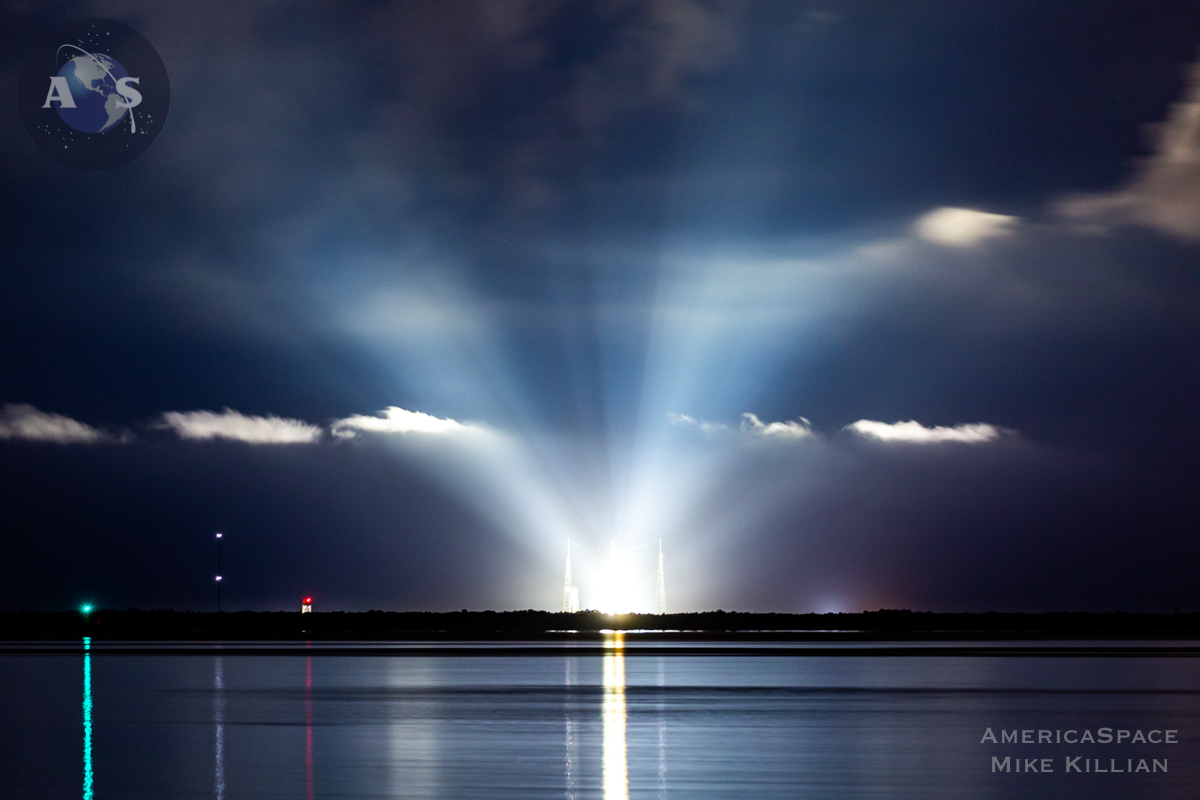
The Blast Danger Area around Pad 39B was cleared just after noon EST on the 15th, ahead of the countdown’s first built-in hold at T-6 hours and 40 minutes. During the hold—which was lengthened to 3.5 hours—the launch team conducted weather and tanking briefings, before Ms. Blackwell-Thompson authorized the loading of 733,000 gallons (3.3 million liters) of liquid oxygen and hydrogen propellants into the Core Stage and the 45-foot-tall (13.7-meter) upper stage, known as the Interim Cryogenic Propulsion Stage (ICPS).
Fueling occurred in a two-step fashion, with the Core Stage tanks firstly slow-filled, then fast-filled, ahead of the kick-start bleed test to thermally condition the four RS-25 engines as the late afternoon faded into dusk. As night fell on the evening of the 15th, topping and replenishment of the Core Stage got underway and the ICPS was itself loaded with 22,000 gallons (100,000 liters) of liquid oxygen and hydrogen.
As the countdown moved inside its final hour, the final NASA Test Director (NTD) briefing was held and Ms. Blackwell-Thompson polled her team for their preparedness to launch. With a “Clear Constraints Board”, the countdown resumed from its final built-in hold at T-10 minutes, as the Ground Launch Sequencer (GLS) took control and the pace of automated activities picked up.
Shortly after 9:30 p.m. EST, the fueling process was interrupted by the appearance of a small leak on a hydrogen valve in the Mobile Launcher (ML). A “red crew” of technicians were dispatched to the pad, entered the ML’s base area—or “zero deck”—and tightened several bolts to ensure that the valve was secure. The issue did not recur.
But shortly before 1 a.m. EST, with the countdown clock holding in its final built-in hold at T-10 minutes, a delay was announced. Teams extended the built-in hold past its targeted 30 minutes, revealing that the Eastern Range had resolved a loss-of-signal issue pertaining to a radar site and were working through tests to ensure satisfactory communication and tracking of the SLS.
As the countdown moved deep inside its final hour, a final briefing was held by NASA Test Director (NTD) Jeff Spaulding was held and Ms. Blackwell-Thompson polled her team for their preparedness to launch. “For the Artemis Generation,” she said in her final remarks, “this is for you!”
At 1:37 a.m. EST, the countdown clock resumed counting from T-10 minutes, tracking a liftoff at 1:47:44 a.m. At this point, the Ground Launch Sequencer (GLS) took control and the pace of automated activities picked up.
Over the next few excitement-tinged minutes, GLS commanded the pressurization of the SLS Core Stage tanks, armed the FTS for flight and finally handed off control of the countdown to the rocket’s Autonomous Launch Sequencer (ALS) at T-33 seconds. In a fashion oddly similar to the final moments before shuttle launches of yesteryear, the familiar flurry of hydrogen burn-off igniters appeared at T-12 seconds, before the four RS-25s themselves roared alive at staggered intervals at T-6.6 seconds.
“And here we go,” reported NASA’s Derrol Nail. “Hydrogen burn-off igniters activated. Seven…six…Core Stage Engine Start…three…two…one…”
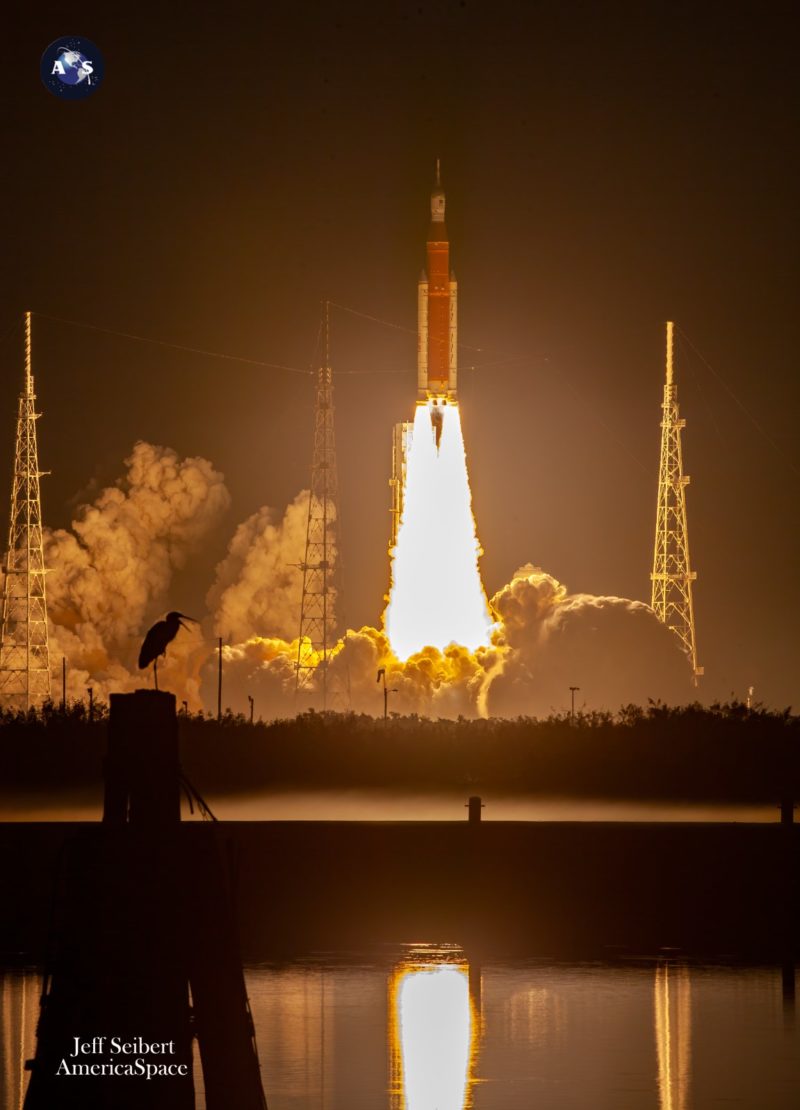
Those four engines previously supported 21 shuttle missions from John Glenn’s historic return to space in October 1998 to the final voyage of the program in July 2011. At T-0, Northrop Grumman’s five-segment SRBs ignited with a characteristic staccato crackle and Artemis I went airborne under a combined thrust of 8.8 million pounds (3.9 million kilograms).
“…zero…boosters ignition,” continued Mr. Nail, almost stumbling over his words in the pandemonium of excitement, “and liftoff of Artemis I. We rise together, back to the Moon and beyond!”
Punching out more than a million pounds (450,000 kilograms) greater thrust than did the Saturn V at liftoff, Artemis I instantly went into the record books as the most powerful rocket ever successfully launched into orbit. Although the Soviet Union’s ill-fated N-1 lunar rocket was capable of 10.2 million pounds (4.6 million kilograms) at liftoff, its four attempted launches between February 1969 and November 1972 all failed.
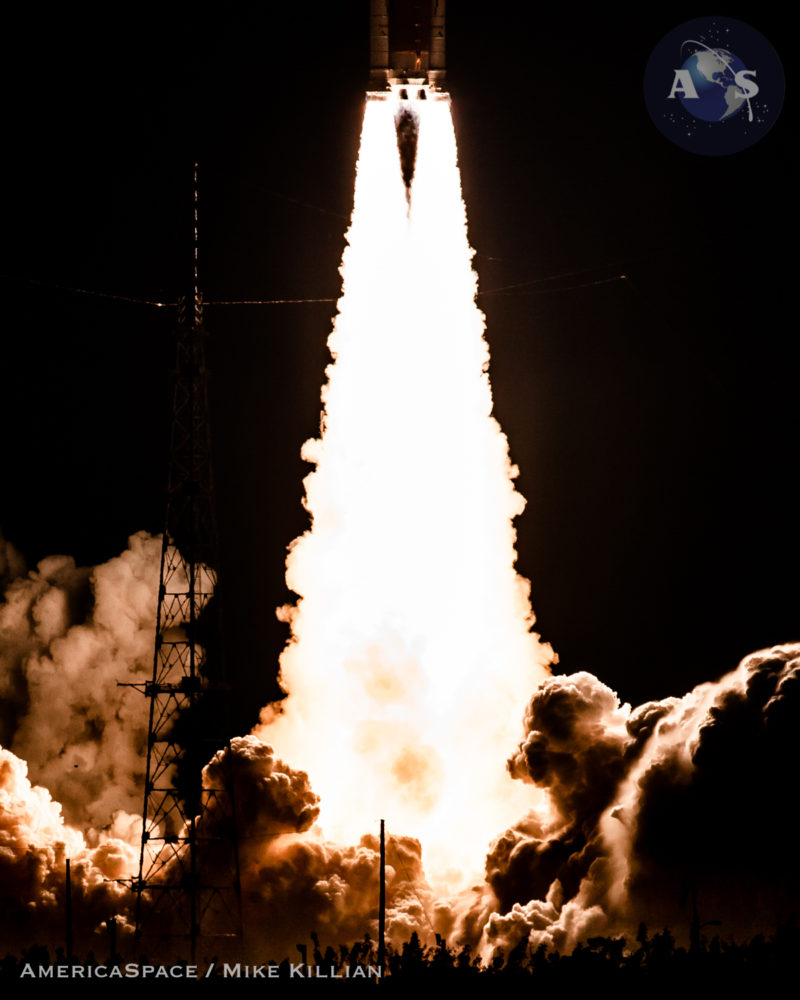
Pummeling the ears and the soles of feet of spectators, Artemis I headed rapidly aloft and downrange, going supersonic at 54 seconds and passing the point of peak aerodynamic turbulence on her airframe—known colloquially as “Max Q”—at 70 seconds. The twin SRBs expended their solid propellant and were jettisoned from the stack at 132 seconds, by which time the vehicle was spearing towards orbit at 3,170 mph (5,100 km/h) at an altitude of 29.9 miles (48 kilometers).
A minute later, protective panels surrounding the ESM were discarded, exposing its stowed solar arrays, and at 210 seconds the Launch Abort System (LAS) was discarded to expose Orion’s CM to the space environment for the first time. By now, Artemis I was traveling well in excess of 4,500 mph (7,200 km/h) at an altitude of 54.4 miles (87.6 kilometers) above the planet.
The four RS-25 engines of the Core Stage continued to burn hot and hard after the departure of the SRBs, before finally burning out for a nominal Main Engine Cutoff (MECO) at eight minutes and 20 seconds. “Nominal MECO, nominal MECO,” Ms. Blackwell-Thompson signaled to her team in the Launch Control Center, with an exultant thumbs-up. By now, Artemis I was flying at an altitude of 100.6 miles (161.9 kilometers), moving at a velocity of 17,430 mph (28,000 km/h).
Ten seconds after MECO, the 21-story Core Stage separated, leaving the ICPS/Orion combo alone to transport the first human-capable vehicle in five decades to lunar distance. The excitement on the ground was palpable.
Taking the microphone to speak to her team, Ms. Blackwell-Thompson’s words were filled with emotion and admiration. “What we’ve done today,” she said, “will inspire generations to come. Thank you for your resilience.
“I said at the pre-test briefing: the harder the climb, the better the view,” she added. “We showed the Space Coast tonight. What a beautiful view it is.”
FOLLOW AmericaSpace on Facebook and X!
Missions » SLS »



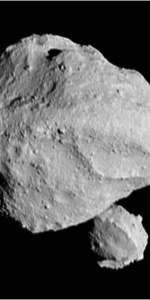
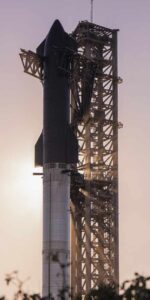
If you want a good fireworks show—pick Starship.
If you want to go to the Moon?
SLSuccess!